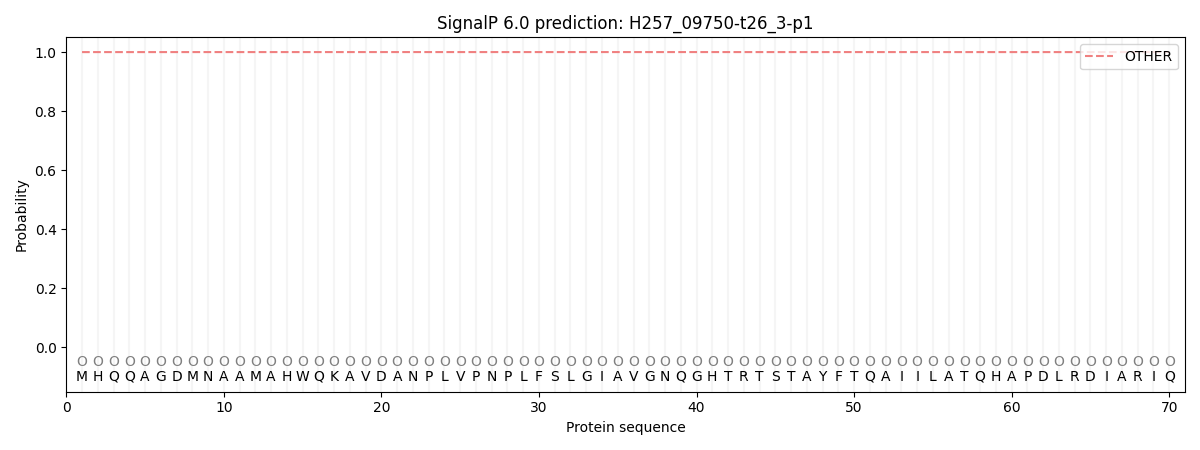You are browsing environment: FUNGIDB
CAZyme Information: H257_09750-t26_3-p1
You are here: Home > Sequence: H257_09750-t26_3-p1
Basic Information |
Genomic context |
Full Sequence |
Enzyme annotations |
CAZy signature domains |
CDD domains |
CAZyme hits |
PDB hits |
Swiss-Prot hits |
SignalP and Lipop annotations |
TMHMM annotations
Basic Information help
| Species | Aphanomyces astaci | |||||||||||
|---|---|---|---|---|---|---|---|---|---|---|---|---|
| Lineage | Oomycota; NA; ; Saprolegniaceae; Aphanomyces; Aphanomyces astaci | |||||||||||
| CAZyme ID | H257_09750-t26_3-p1 | |||||||||||
| CAZy Family | GH5 | |||||||||||
| CAZyme Description | hypothetical protein, variant 2 | |||||||||||
| CAZyme Property |
|
|||||||||||
| Genome Property |
|
|||||||||||
| Gene Location | Start: 508474; End:512234 Strand: + | |||||||||||
Full Sequence Download help
| MHQQAGDMNA AMAHWQKAVD ANPLVPNPLF SLGIAVGNQG HTRTSTAYFT QAIILATQHA | 60 |
| PDLRDIARIQ HATSLLPRVY ESTDEIVLVR HQFQAALDSL LADSPLNLGH NPIYTTGCGS | 120 |
| MGYYLVYQGG VNKPLRRQLA QIYTLSMPAL GFVAPHVLAS RHQTFQFPHT SRYVRHPPQP | 180 |
| PNESGYSSIS LTRRIRVGIL SSFMYHHSVG LLMQGVLTRL SNATYELVLL RSRPWQHDHV | 240 |
| SRHAAAHMSQ DIQLPTDVFQ AQRVVAALEL DILVFTEIGM DPGTYFLAFS TLALRSVLFW | 300 |
| GHAITSGLST VDYFITSDLF NSNPDEFTET LYPMQSLTTL FRRPKFTFDR SLLTFLPTIE | 360 |
| PHNVLFVVPQ TLYKLHPDMD AILAAILTGL PHSYVVLLEG SVPHLATLIQ RRLGRVLSPQ | 420 |
| DLHTRVVFAP YLSTDAFLTL CQVADVVLDP FPVGGGRSSL EIFSVGTPVV VHRNRTSIVQ | 480 |
| LTAAMYTKMN ITTCCVASSD AAYVAMAIHL GSNTSYRDEL SSLIQRRSSV LYDSDAATVA | 540 |
| DVMNDWDQCL HTILAMPPPP SNRSQPTPVN RLGFRLQVAG QPSVEVVLRS NDEEPAAVAA | 600 |
| AVAASHKLEP LHQYYIQTLL FNGLQRWRQQ SPQVAISADV FPGMTPPVDV YVGDDVALAV | 660 |
| HVHLWRYKYR MSGTELGHVI ASIRSALNHA DESTLWIAAR GAQYPPPPPT PPLRSFIAPL | 720 |
| VSHQTCVTVV VTTCKRLSLF LATMHSFLPY AATSSVCMLL VLDDHSSAAD RRVMQDTFPA | 780 |
| VEFVFTRRKG HAHSLNTMLE LVTTRFMLYL EDDWRWEPSL PHHPLAHALA ILEHDPTIVQ | 840 |
| VLVNTQHSGW PRRLPTTDDS SFGLYFRHEY GVVDHAFGYW PGFSLNPGVW DLKRLSRCPA | 900 |
| LRFNESSDVF EREFSLAVWR CGLHVAMLPY TTAVHIGTNG SAYVLNGLPR RFD | 953 |
CAZyme Signature Domains help
| Family | Start | End | Evalue | family coverage |
|---|---|---|---|---|
| GT41 | 2 | 529 | 7.3e-59 | 0.5063829787234042 |
CDD Domains download full data without filtering help
| Cdd ID | Domain | E-Value | qStart | qEnd | sStart | sEnd | Domain Description |
|---|---|---|---|---|---|---|---|
| 226428 | Spy | 1.03e-26 | 176 | 538 | 240 | 604 | Predicted O-linked N-acetylglucosamine transferase, SPINDLY family [Posttranslational modification, protein turnover, chaperones]. |
| 133045 | CESA_like | 0.003 | 759 | 852 | 29 | 128 | CESA_like is the cellulose synthase superfamily. The cellulose synthase (CESA) superfamily includes a wide variety of glycosyltransferase family 2 enzymes that share the common characteristic of catalyzing the elongation of polysaccharide chains. The members include cellulose synthase catalytic subunit, chitin synthase, glucan biosynthesis protein and other families of CESA-like proteins. Cellulose synthase catalyzes the polymerization reaction of cellulose, an aggregate of unbranched polymers of beta-1,4-linked glucose residues in plants, most algae, some bacteria and fungi, and even some animals. In bacteria, algae and lower eukaryotes, there is a second unrelated type of cellulose synthase (Type II), which produces acylated cellulose, a derivative of cellulose. Chitin synthase catalyzes the incorporation of GlcNAc from substrate UDP-GlcNAc into chitin, which is a linear homopolymer of beta-(1,4)-linked GlcNAc residues and Glucan Biosynthesis protein catalyzes the elongation of beta-1,2 polyglucose chains of Glucan. |
| 276809 | TPR | 0.004 | 2 | 72 | 11 | 81 | Tetratricopeptide repeat. The Tetratricopeptide repeat (TPR) typically contains 34 amino acids and is found in a variety of organisms including bacteria, cyanobacteria, yeast, fungi, plants, and humans. It is present in a variety of proteins including those involved in chaperone, cell-cycle, transcription, and protein transport complexes. The number of TPR motifs varies among proteins. Those containing 5-6 tandem repeats generate a right-handed helical structure with an amphipathic channel that is thought to accommodate an alpha-helix of a target protein. It has been proposed that TPR proteins preferentially interact with WD-40 repeat proteins, but in many instances several TPR-proteins seem to aggregate to multi-protein complexes. |
CAZyme Hits help
| Hit ID | E-Value | Query Start | Query End | Hit Start | Hit End |
|---|---|---|---|---|---|
| QEM68384.1|GT41 | 1.45e-52 | 72 | 533 | 124 | 552 |
| BAP54338.1|GT41 | 5.86e-51 | 68 | 533 | 138 | 570 |
| QGQ32129.1|GT41 | 3.06e-50 | 74 | 623 | 487 | 989 |
| QEG14440.1|GT41 | 3.06e-50 | 74 | 623 | 487 | 989 |
| QDU12502.1|GT41 | 3.06e-50 | 74 | 623 | 487 | 989 |
SignalP and Lipop Annotations help
This protein is predicted as OTHER

| Other | SP_Sec_SPI | CS Position |
|---|---|---|
| 1.000075 | 0.000000 |
